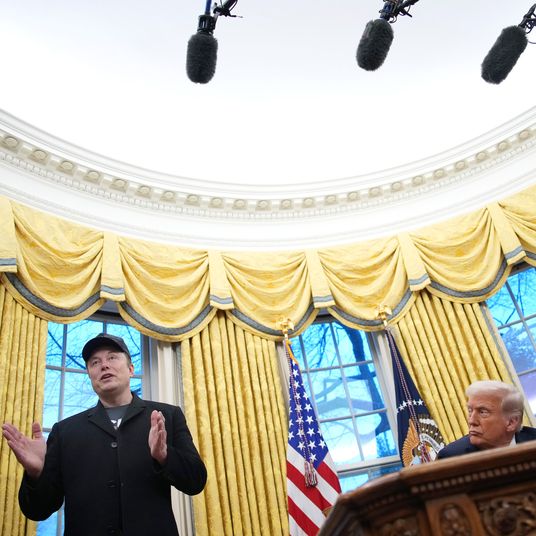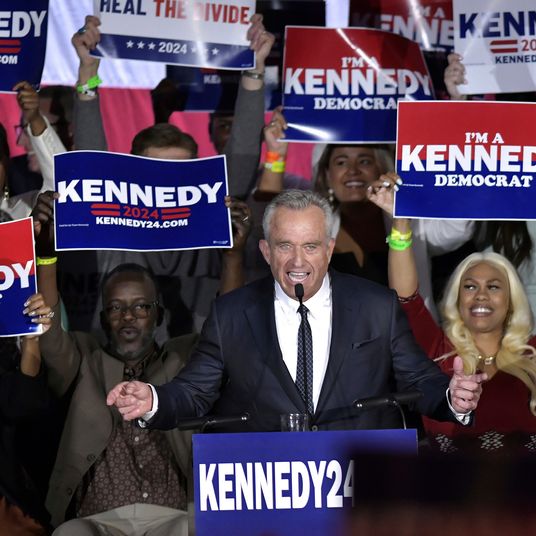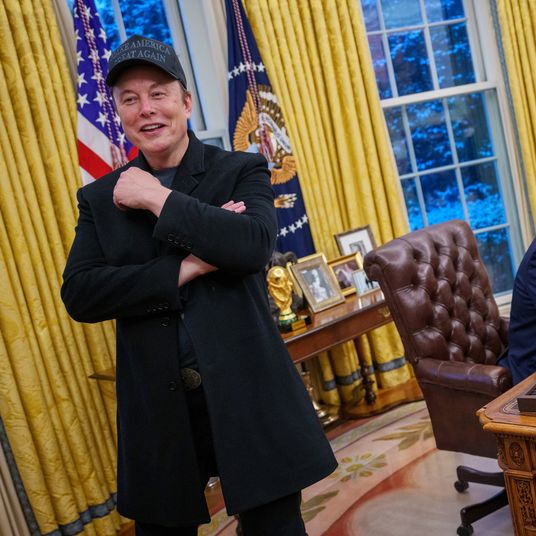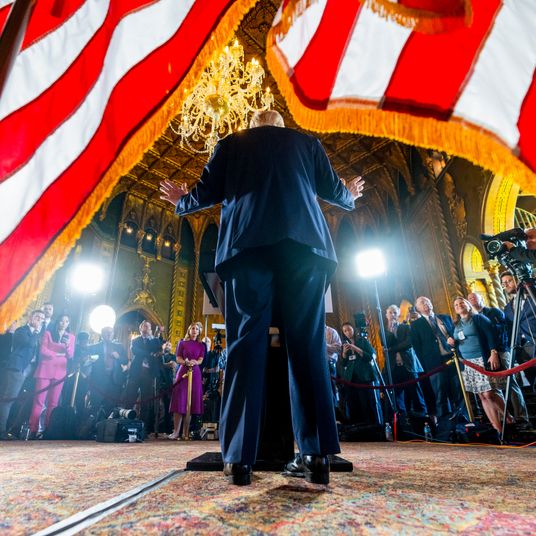
Earlier this year, Elizabeth Warren pandered to Republican voters by calling for the expropriation of the one percent’s wealth.
The senator’s proposed tax on the capital of America’s plutocrats alienated the median stockbroker. It also revealed that the former Harvard professor was badly out of touch with the hardworking, salt-of-the-earth, center-right pundits and economists who built this country. And their antipathy wasn’t hard to understand. Taxing wealth is an even greater affront to property rights and neoliberal orthodoxy than hiking top marginal rates. Plotted on a left-to-right ideological spectrum, Warren’s plan would be far off-center.
But it did play well with the liberal elites who apparently make up the GOP base: When Morning Consult ran Warren’s scheme by Republican voters, they supported it by 50 to 30 percent margin.
This finding reflected a simple fact that mainstream political coverage habitually elides: There is no tight correlation between a policy’s ideological extremity — as judged by its distance from status quo policy or the dictates of political theory — and its electoral viability. Many “far left” ideas are broadly popular (e.g., installing workers’ representatives on corporate boards, soaking the rich, giving federal jobs to all the unemployed), while some “centrist” ones are politically toxic (“entitlement reform,” the individual mandate for health insurance).
Nevertheless, much of the press persists in using “left wing” as an antonym for political pragmatism. Which is unfortunate, since it muddles a necessary debate about the genuine electoral trade-offs that Democrats face.
A recent New York Times column titled “What Democrats Could Lose With Their Left Turn” is illustrative of the problem. The piece’s author, Alexander Agadjanian of MIT’s Election Lab, aims to assess whether the left-wing bent of the Democrats’ 2020 debate is undermining the party’s prospects of beating Trump. To that end, he conducted the following survey experiment:
A random half of participants read a news snippet illustrating the leftward shift, while the other half read about unrelated topics, such as the schedule of election dates. The news item was a few sentences that included policies discussed by the candidates: decriminalizing unauthorized border crossings; expanding undocumented immigrants’ access to government services; replacing private health insurance with a government-run system; and establishing free public college for all children from working-class families. The content was drawn directly from real news coverage.
Both sets of respondents then indicated how they planned to vote in 2020 (whether for President Trump or the eventual Democratic nominee), how strongly they were considering voting Democratic, and how motivated they felt to turn out and vote for or against the Democratic nominee.
Agadjanian found that independent voters exposed to the Democrats’ “leftward shift” were six points less likely to support the party in 2020 than those who read about unrelated topics. Meanwhile, Democratic voters who read about their party’s left-wing policies were mildly more emphatic in their support of their party’s nominee. Taken together, the survey’s results suggest the left-wing policies Agadjanian polled are a significant net negative for Democrats — one conceivably large enough to cost them the election.
Agadjanian is admirably careful in contextualizing his findings. He notes that some progressive policies are popular, and that it is unclear which left-wing policies the Democratic nominee will choose to emphasize next year. Still, the framing of both his column and survey are misleading. The question he has examined is not “Do Democrats risk losing independents by moving left?” but rather, “If three of the Democratic Party’s least popular left-wing ideas are at the front of independent voters’ minds when they enter the ballot booth next year, will that be bad for the Democratic Party?”
The second question is more worthwhile than it may sound. Previous polling has established that decriminalizing border crossing, extending health-care benefits to undocumented immigrants, and abolishing private insurance are not majoritarian propositions (although, the last one tends to have broader support when contextualized in specific ways). But policies can be unpopular without being salient. So there is some value in knowing that these stances could ostensibly inform the voting preferences of swing constituencies.
There is no value, however, in casting these three policies as definitive of the Democratic Party’s ideological shift. A survey that had independent voters read about the Democratic field’s embrace of wealth taxes, worker codetermination, marijuana legalization, and a $15 minimum wage might very well yield the opposite conclusion about the electoral implications of the Democrats’ “left turn,” given the broad popularity of those ideas. By equating the political viability of an arbitrary (and unusually unpopular) batch of left-wing policies with that of Democrats “moving left” in general, the Times column provided progressives readers with an easy means of dismissing its findings outright.
And that’s regrettable, since Agadjanian’s findings are worthy of consideration when properly contextualized. There are some genuine tensions between ideological progressivism and political pragmatism. Majoritarian opinion is not ideologically consistent. Voters lean left on some issues, and right on others. All else being equal, a politician whose issue positions are determined by ideological conviction — whether progressive, conservative, or centrist — will be more vulnerable to opposition attacks than one who outsources her agenda to (competent) pollsters and consultants.
Meanwhile, some aspects of progressive ideology put the left in perpetual tension with majoritarian intuitions. The left exists to oppose arbitrary hierarchy and champion those who are oppressed and exploited by the status quo social order. In a context of extreme economic inequality, this commitment aligns progressives with the vast majority (if not quite 99 percent) of Americans in their capacity as workers. Thus, it isn’t too surprising that the left often boasts majoritarian positions on questions that concern the balance of power between economic classes. And yet, progressives’ commitment to representing the downtrodden also compels them to oppose unjust hierarchies that serve the (unenlightened) interest of most Americans. In a debate between capital and labor, standing with the people who work for a living tends to be an electorally expedient proposition. In a debate that (ostensibly) pits the interests of U.S. citizens against those of undocumented immigrants, standing up for the side that lacks voting rights tends to be electorally disadvantageous. And the same is true of policy disputes that put the immediate interests of America’s white majority and its black minority at cross-purposes.
This does not mean that the left should cease fighting to secure social protection for the undocumented or reparations for African-Americans. But it does suggest that the left can’t presume its moral truths are self-evident to the 99 percent it claims to champion, or the 50-plus percent of voters whose support it aims to win. If progressives wish to maximize their near-term power, then their electoral strategy must account for majoritarian sentiment. Which is to say, it must be formulated around unsentimental answers to questions like: Where are voters with us, and where are they against us? What is the probability of changing the public’s mind on [unpopular policy x] within the duration of a single election cycle (i.e., how widespread and consistent over time is the public’s opposition to our stance)? How salient is [unpopular policy x] with swing constituencies? Is there a way to mitigate the electoral detriment of [unpopular policy x] without abandoning our commitment to advancing that goal?
Agadjanian’s experiment doesn’t tell us that a Democratic nominee who endorses the decriminalization of border crossing will inevitably lose significant support for doing so. Among other things, his survey design is a poor approximation of a general-election messaging environment; presumably, the typical independent voter will be exposed to information about some of the GOP’s less popular positions next fall. And yet Agadjanian’s respondents were presented exclusively with unpopular Democratic stances. For this reason, it’s not at all clear that independent voters’ antipathy for left-wing immigration policy or anxiety about nationalizing the health-insurance industry would overwhelm their opposition to tax cuts for the rich, or Republican attacks on Medicaid.
What the survey experiment does establish, however, is that the Democratic nominee will have an interest in minimizing the salience of her party’s most unpopular stances (which are not necessarily its most “left wing” ones). The incentives of the Democratic primary, unfortunately, have led many candidates to do the opposite: In order to distinguish themselves in a crowded field, lesser-known contenders have loudly embraced positions that their rivals deemed too politically dicey, while Sanders supporters have emphasized the most unpopular aspects of Medicare for All in order to separate the policy’s true believers from its fake friends.
In a better world, progressive interest groups would be able to operate like GOP-aligned corporate lobbies. Payday lenders don’t demand Republican presidential candidates campaign on a pro-usury message. And Big Coal raised no complaint when Donald Trump insisted that his administration would make clean air and water a top priority. These interest groups understood that their demands were electorally dicey. And they knew that a Trump administration could be trusted to advance their aims, regardless of what the candidate said on the campaign trail. For good reason, advocates for the undocumented and uninsured lack such confidence in the Democratic Party. And that raises difficult questions about how the benefits of pressuring candidates into publicly championing the progressive position on any given wedge issue stack up against the potential electoral risks of such advocacy.
There are real tensions between the goals of maximizing the progressivity of the Democratic agenda, and minimizing the near-term power of the Republican Party. And such tensions merit examination and debate. But punditry that ignores the electorally expedient aspects of the progressive agenda, and tacitly equates centrism with pragmatism, does little to promote such nuanced discussions and may even preempt them. The available evidence suggests that the Democratic Party can simultaneously move left and into power — it just needs to take care when mapping out its route.































